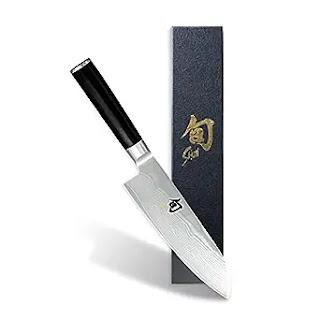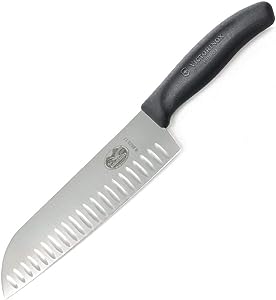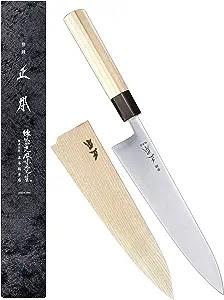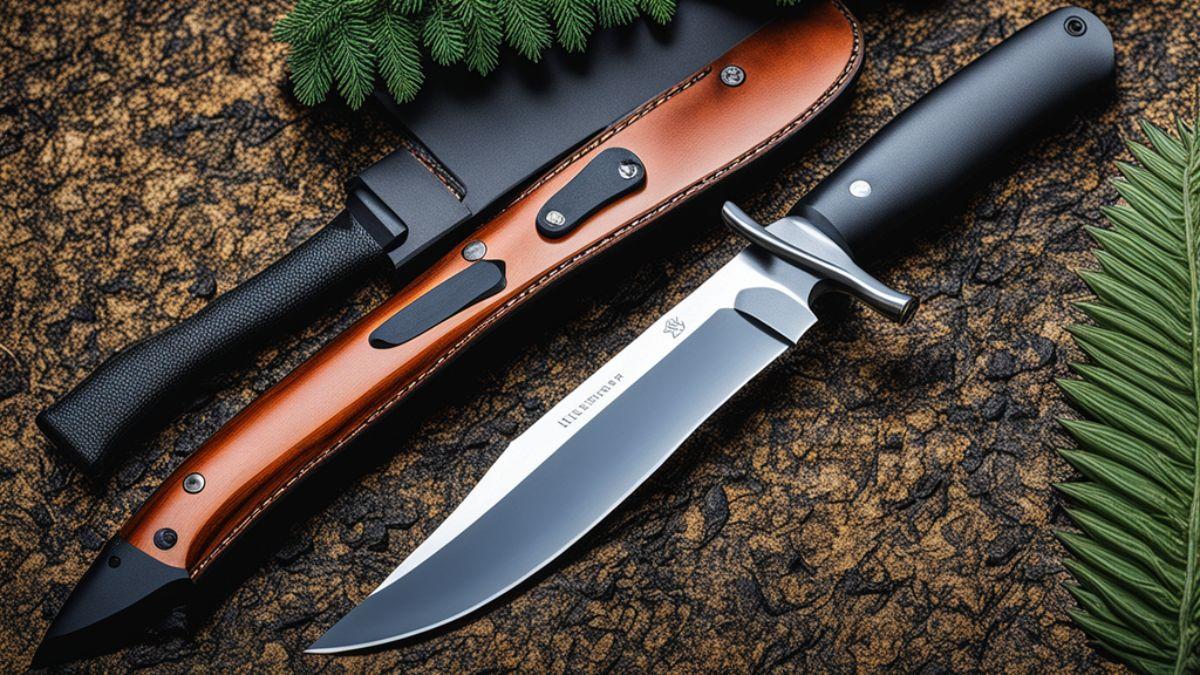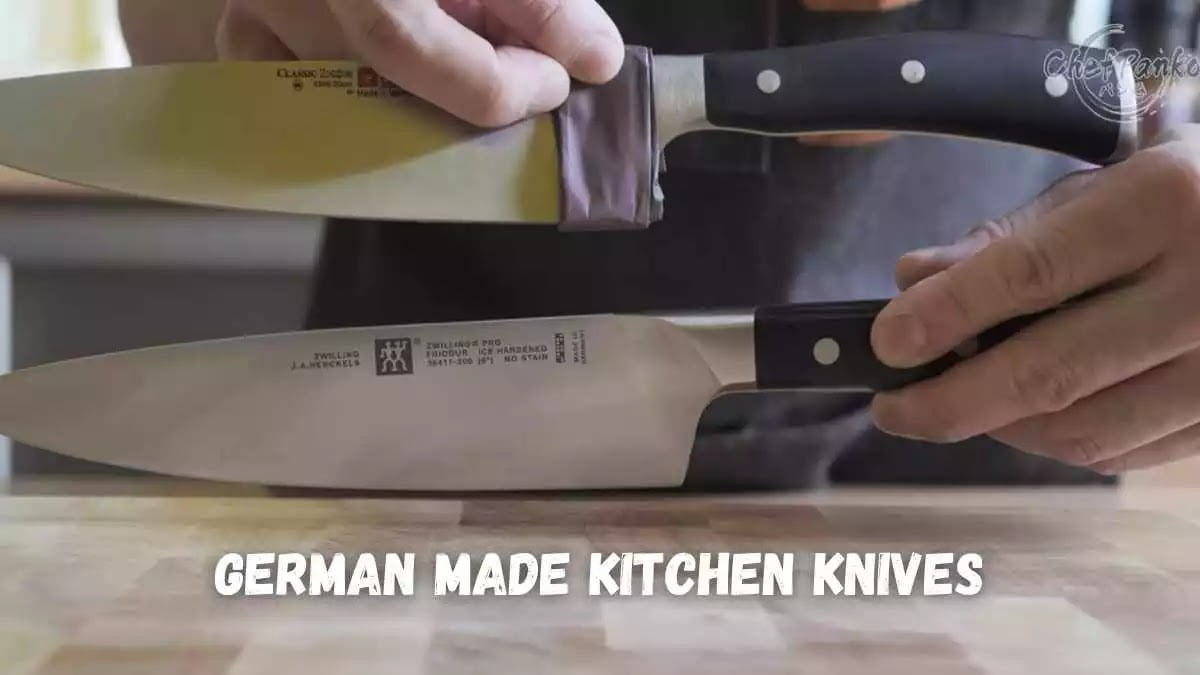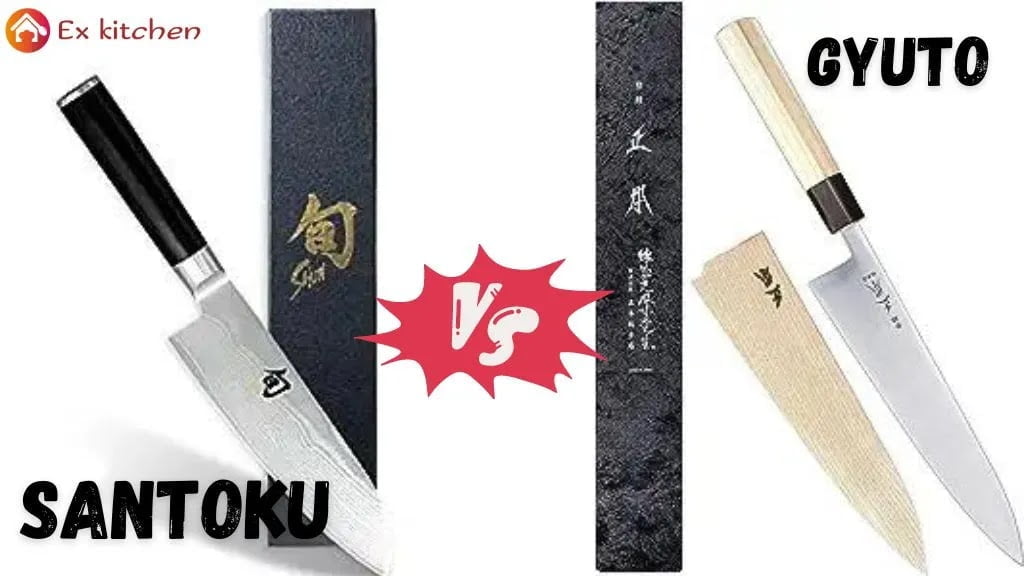
We may earn money or products from the companies mentioned in this post.
So you’re looking for a new chef’s knife and have narrowed it down to two popular Japanese models: the santoku and the gyuto. The Santoku knife has grown in popularity in domestic kitchens all throughout the world, but the gyuto is a workhorse knife used by many professional cooks. You’ve certainly seen both sorts of knives used on culinary shows and in internet tutorials, but you’re not sure which is best for you.
Read More: What is a Serrated Knife Used For?
Santoku vs Gyuto: What’s the Difference?
The santoku and gyuto are two of the most common types of Japanese chef’s knives. But how can you decide which one to go with? Let’s evaluate these knives side by side so you can select the best one for you.
Santoku
A versatile knife that can be used for slicing, dicing, and mincing is the Santoku. Its blade, which is normally 5 to 8 inches long and wider than the typical Western chef’s knife, is shorter. The blade of the santoku has a sheepsfoot tip and a long, straight cutting edge that enables steady, accurate cuts.
The Santoku is a fantastic option if you’re looking for a flexible, agile knife for chopping vegetables, herbs, and smaller portions of meat. It is a bit more forgiving for novices due to its shorter blade and rounded tip. Larger fruits and chunks of meat, however, could be difficult for the santoku to handle. Additionally, due to its flat cutting edge, it is more difficult to rock chop than a Western knife.
Gyuto
The gyuto is a Japanese version of the Western chef’s knife. It has a longer, narrower blade, usually 8 to 12 inches long, with a pointed tip. The gyuto is suitable for slicing, dicing, and mincing most foods. Its longer, tapered blade allows for rocking cuts and efficiently slicing larger items.
The gyuto is a great choice if you want an all-purpose knife that can do practically any task. However, its longer pointed blade requires more precision and may be trickier for beginners to control. The gyuto also typically costs a bit more than a santoku due to its larger size.
In the end, you need to weigh your priorities – versatility, control, or budget. Either the santoku or gyuto would make a great addition to any kitchen. But choosing the one that matches your needs and skills will ensure you get the most use out of your new knife.
Read More: The Best Knife for Cutting Vegetables: Top 5 Reviews
Santoku Knife Pros and Cons
When it comes to santoku knives, you’ll find both pros and cons to consider:
Versatility
A major benefit of the Santoku knife is how versatile it is. With its wider blade, the santoku can handle slicing, dicing, and mincing a variety of ingredients. The santoku’s blade shape and size also make it ideal for scooping up chopped ingredients to transfer them elsewhere. If you want an all-purpose knife that can tackle various cutting tasks, the santoku is a great choice.
Control
The santoku’s shorter blade and rounded tip provide more control and precision. This makes the santoku ideal for delicate tasks where accuracy is key, like mincing garlic or herbs. However, the shorter blade can make cutting larger ingredients like squash or melons more difficult.
Maintenance
Santoku knives typically require more frequent sharpening since they have a wider blade. The blade’s width also means santokus can be trickier to sharpen evenly. You’ll need to sharpen the entire edge, from heel to tip, to maintain the proper cutting angle.
In the end, the Santoku knife has a lot to offer home cooks looking for a versatile and precise knife. However, its wider blade does come with some downsides like more frequent maintenance and difficulty cutting larger foods. For many common kitchen tasks though, the santoku’s pros far outweigh its cons. If control and precision are priorities for you, the Santoku knife could be an excellent choice.
Read More: Vegetable Knife vs Chef Knife: Which One is Right for You?
Gyuto Knife Pros and Cons
The gyuto is a popular Japanese chef’s knife that’s similar to a Western chef’s knife. It’s a great all-purpose knife that can handle most cutting tasks. However, there are some pros and cons to consider before choosing a gyuto.
Pros
- Versatile. The gyuto can slice, dice, and chop vegetables, meat, and fish with ease. Its blade shape and length make it suitable for most kitchen-cutting tasks.
- Sharp edge. Gyutos are made of hard steel and honed to a very sharp edge. This makes cutting effortless and efficient.
- Stylish. Gyutos has a sleek, modern profile that looks great in any kitchen. Their hammered or Damascus steel blades are works of art.
Cons
- Can be pricey. High-quality guys made of premium steel can be quite expensive. While they’ll last a lifetime with proper care, the initial cost may be a barrier for some home cooks.
- Require frequent honing. The hard steel used in autos needs to be regularly honed to maintain *its sharp edge. You’ll need to invest in a quality honing rod or whetstone and learn how to properly hone the blade.
- Can be fragile. The thin, hard blade of a gyuto may be prone to chipping or breaking if used improperly or on frozen foods. You need to exercise care and only use the knife for its intended
In the end, a gyuto can be an excellent choice if you want a stylish, high-performance knife and are willing to properly care for it. For occasional or casual cooking, a santoku may be a more practical and budget-friendly option. But for serious home cooks and professionals, a gyuto is hard to beat.
Santoku vs Gyuto Blade Shape Comparison
The blade shape is one of the biggest differences between Santoku and gyuto knives. The santoku features a shorter, wider blade that is ideal for chopping, while the gyuto has a longer, narrower blade better suited for slicing.
Santoku Blade
The Santoku blade is shaped like a wedge, with a wide spine that tapers down to a pointed tip. It typically measures between 5 to 8 inches long. The wide blade makes it easy to scoop up chopped ingredients from the cutting board. The wedge shape also provides more surface area, so you can chop more with each stroke. The shorter length offers more control and precision.
Gyuto Blade
The gyuto blade has a longer, narrower shape, usually 8 inches or longer. It resembles a classic Western chef’s knife. The length and narrowness of the blade are ideal for slicing meat, fish, and vegetables. The pointy tip also allows you to easily pierce into foods. While the longer blade may take some getting used to, it can be very versatile and efficient for most kitchen tasks. The length does require more storage space, however.
In the end, the blade shape comes down to personal preference and how you like to cut and chop. If you do a lot of chopping and want maximum efficiency, the Santoku blade shape may appeal more. For slicing and multipurpose use, the gyuto blade could be a better choice. Many home cooks find themselves reaching for their santoku for some tasks and their gyuto for others. There’s no rule that says you have to choose only one!
Having the right tools for your cooking style will make meal prep more enjoyable. Comparing the differences in Santoku and gyuto blade shapes is a great step towards finding a knife that feels like an extension of your hand.
Read More: Best Knife Sets Under $200: Uncover the Ultimate Cutting Experience
Santoku vs Gyuto Uses in the Kitchen
When deciding between a santoku or gyuto knife, think about how you like to cook and what techniques you use most in the kitchen. Both are versatile Japanese chef’s knives used for slicing, dicing, and mincing, but they have some key differences.
Blade shape
The Santoku has a wider, flatter blade that’s ideal for chopping. The gyuto has a longer, pointed blade that’s better suited for slicing. If you do a lot of chopping vegetables, the santoku’s blade shape would probably suit you well. For slicing meat or fileting fish, the gyuto’s narrower blade would likely work better.
Size
Santoku knives typically range from 5 to 8 inches in length, while gyutos are usually 8 to 10 inches or longer. A smaller santoku knife gives you more control and precision for small tasks. A larger gyuto can handle bigger cutting jobs efficiently. Consider what sizes of ingredients you work with and how much control versus efficiency you want.
Weight
In general, santoku knives are lighter than gyutos. A lighter santoku knife reduces hand fatigue and gives you more control, making it ideal for people with smaller hands or less cutting experience. A heavier gyuto provides more power but may be tiring for long tasks. If you have larger hands or often cut dense, hard ingredients, a gyuto’s extra weight could be an advantage.
Uses
A santoku knife works well for mincing garlic and herbs, slicing vegetables, and boneless meats. A gyuto can also handle these tasks but truly shines when slicing larger cuts of meat, chopping hard vegetables, or fileting fish. If you frequently break down chickens, cut root vegetables, or slice roasts, a gyuto would probably suit you well. For lighter tasks, a santoku should work great.
In the end, choosing between a santoku or gyuto comes down to your cooking style and preferences. Either can work as a versatile go-to knife in a home kitchen. Think about how each knife’s unique qualities align with how you like to cook, and you’ll find your perfect match.
How to Choose Between Santoku and Gyuto
When choosing between a santoku or gyuto knife, think about how you like to chop and slice. The Santoku is an all-purpose knife great for small or medium tasks. The gyuto is ideal if you want a knife that can handle larger jobs or more precision work.
Santoku
The Santoku knife is shorter and lighter, with a blade of around 5 to 7 inches, so it’s easy to maneuver. Its blade has a sheepsfoot tip and a flattcurve, making itve, ideal for chopping. The santoku excels at mincing garlic and herbs, dicing onions, and slicing vegetables. It can handle most everyday cutting tasks for home cooks. However, its shorter blade may frustrate some cooks or limit the size of items it can cut.
Gyuto
The gyuto knife has a longer, curved blade ranging from 8 to 12 inches, resembling a Western chef’s knife. Its pointed tip allows for precise cuts and its length provides more knuckle clearance when chopping. The gyuto can power through larger fruits and vegetables as well as proteins. It’s a very versatile knife that works well for both chopping and slicing. However, its larger size requires more space and can feel unwieldy for some cooks or smaller tasks.
Making the Choice
When selecting between these two popular Japanese knives, determine how much precision and power you need. If you want an agile knife for most small or medium jobs, the santoku should work great. If you frequently cut larger items or want more versatility, the gyuto is probably your best bet.
Some other things to consider:
- Your cutting technique – If you prefer chopping, the santoku excels. For longer slicing cuts, the gyuto is better.
- Kitchen space – The larger gyuto requires more room to use and store. The Santoku is more compact.
- Price – Santoku knives are often a bit more affordable. Gyutos vary more in price depending on size and quality.
- Esthetics – Santokus typically have a rounder, sheep foot blade while gyutos have a pointed tip and longer, tapered blade. Choose the shape you prefer.
Whether you opt for the nimble santoku or the multi-purpose gyuto, you’ll have an excellent knife that should last you for many meals to come. Think about how and what you like to cut, then choose the knife that suits your needs and skills. With the right blade in hand, you’ll be slicing and dicing in style.
Top Santoku Knife Recommendations
When it comes to Santoku knives, you have many excellent options to choose from. Here are some of the top recommendations:
Premium Pick
Miyabi Kaizen 7-Inch Santoku Knife

- This high-quality santoku knife from Miyabi is made from forged SG2 steel and has a stunning floral Damascus pattern. It has a very sharp edge and a comfortable pakkawood handle. The blade is thin and lightweight, ideal for precise slicing and dicing. This is a premium knife that will make a statement in any kitchen.
Premium Pick
Shun Classic 7-Inch Santoku Knife

- Shun is one of the most well-known knife brands, and their Classic 7-inch santoku knife is a top performer. It features a VG-MAX steel blade and a walnut-colored pakkawood handle. Shun knives are known for their sharpness and edge retention. This santoku knife excels at chopping vegetables and slicing meat. It’s a high-quality, all-purpose knife that will work well for most home cooks.
Premium Pick
Mercer Culinary Genesis 7-Inch Forged Santoku Knife

- If you’re on a budget, the Mercer Culinary Genesis Santoku knife is an excellent, affordable option. It has a sturdy German steel blade and ergonomic handle. For the price, it offers great performance and durability. The shorter blade is very maneuverable and ideal for small- to medium-sized cutting tasks. This is a great starter santoku knife that punches above its weight class.
Premium Pick
Victorinox 7-Inch Fibrox Pro Santoku Knife

- When it comes to value, Victorinox is hard to beat. Their 7-inch Fibrox Pro santoku knife costs very little but performs like knives twice the price. It has a stamped high-carbon steel blade and slip-resistant Fibrox handle. Victorinox knives are renowned for their quality and durability. This santoku knife is lightweight, sharp, and highly versatile. If you’re on a tight budget, this should be at the top of your list.
- In the end, you can’t go wrong with any of these top-rated santoku knives. Compare the options based on your needs, preferences, and budget to choose a santoku knife you’ll enjoy using for years to come.
Top Gyuto Knife Recommendations
Once you’ve decided between a santoku and a gyuto knife, it’s time to choose a specific gyuto model. Here are some of the top recommendations based on quality, performance, and value:
Premium Pick
Miyabi Birchwood SG2 Gyuto Knife

- This high-end gyuto knife from Miyabi features a blade made of SG2 steel, a type of powdered steel that is very hard and corrosion-resistant. It has a stylish birch wood handle and a 9.5-inch blade. It’s on the pricier side but is a top-quality, high-performance gyuto that should last a lifetime.
Premium Pick
Shun Classic 8-Inch Chef’s Knife

- Shun is one of the most well-known knife brands, and their Classic line is a perennial best-seller. The Shun Classic gyuto knife has an 8-inch blade made of VG-MAX steel, which provides a great balance of sharpness, durability, and stain resistance. It features an ebony pakkawood handle and a full tang for balance. This is a great all-around gyuto for both home and professional cooks.
Premium Pick
Tojiro DP Gyuto Knife

- If you’re on a budget, the Tojiro DP gyuto knife is an excellent, affordable option. It has an 8.2-inch blade made of VG-10 steel, stainless steel that provides good edge retention. The handle is made of molded plastic, so it’s not the most stylish but is very durable and ergonomic. For the money, the Tojiro DP gyuto offers fantastic performance and value. It’s a great starter gyuto for home cooks.
Premium Pick
Masamoto KS Wa Gyuto Knife

- For a traditional Japanese gyuto, consider the Masamoto KS. It features an octagonal ho wood handle, a single-beveled blade made of high-carbon steel, and a distinctive hammered finish. The KS gyuto comes in a variety of sizes, from 210mm up to 270mm. It requires more maintenance than Western-style knives but is a work of art and cuts like a dream. If you want an authentic, top-quality tool, the Masamoto KS gyuto is hard to beat.
The key is finding a gyuto knife that matches your needs, skills, and budget. Whether you opt for a high-performance powdered steel blade or more affordable stainless steel, a gyuto can be a lifelong companion in your kitchen. With proper care and maintenance, a quality gyuto will assist you in becoming a better, more efficient cook.
Conclusion
So there you have it. Santoku or gyuto: which knife should grace your kitchen counter? As with many tools in life, it comes down to personal preferences and needs. If precision and slicing are your priorities, the gyuto’s pointed tip and length are hard to beat. If versatility and an all-purpose option are what you’re after, the Santoku’s compact and balanced design is perfect. Either way, with a quality Japanese knife in your hands, cooking at home just got a whole lot more fun. Now get out there, pick your perfect knife, and start slicing and dicing your way to culinary bliss!

